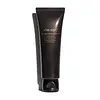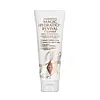What's inside
What's inside
 Key Ingredients
Key Ingredients

 Benefits
Benefits

 Concerns
Concerns

 Ingredients Side-by-side
Ingredients Side-by-side

Myristic Acid
CleansingGlycerin
HumectantStearic Acid
CleansingPotassium Hydroxide
BufferingSorbitol
HumectantDipropylene Glycol
HumectantLauric Acid
CleansingPEG-20 Glyceryl Isostearate
PEG-6
HumectantPEG-32
HumectantSodium Methyl Cocoyl Taurate
CleansingGlyceryl Stearate Se
EmulsifyingGlycol Distearate
EmollientPolyquaternium-7
Parfum
MaskingTrisodium EDTA
Sodium Methyltaurate
Skin ConditioningButylene Glycol
HumectantLinalool
PerfumingCitronellol
PerfumingGeraniol
PerfumingButylphenyl Methylpropional
PerfumingSodium Metabisulfite
AntioxidantPrunus Speciosa Leaf Extract
Skin ConditioningCI 77492
Cosmetic ColorantCI 77491
Cosmetic ColorantMyristic Acid, Glycerin, Stearic Acid, Potassium Hydroxide, Sorbitol, Dipropylene Glycol, Lauric Acid, PEG-20 Glyceryl Isostearate, PEG-6, PEG-32, Sodium Methyl Cocoyl Taurate, Glyceryl Stearate Se, Glycol Distearate, Polyquaternium-7, Parfum, Trisodium EDTA, Sodium Methyltaurate, Butylene Glycol, Linalool, Citronellol, Geraniol, Butylphenyl Methylpropional, Sodium Metabisulfite, Prunus Speciosa Leaf Extract, CI 77492, CI 77491
Water
Skin ConditioningGlycerin
HumectantSodium Cocoyl Glycinate
CleansingDisodium Cocoyl Glutamate
CleansingCitric Acid
BufferingDecyl Glucoside
CleansingGlyceryl Stearate Se
EmulsifyingSodium Cocoyl Glutamate
CleansingSodium Benzoate
MaskingGlycol Distearate
EmollientPentylene Glycol
Skin ConditioningCetyl Hydroxyethylcellulose
Emulsion StabilisingHydrolyzed Cottonseed Protein
Skin ConditioningFructose
HumectantSodium Hydroxide
BufferingUrea
BufferingParfum
MaskingOpuntia Ficus-Indica Stem Extract
Skin ConditioningTetrasodium Glutamate Diacetate
Allantoin
Skin ConditioningMaltose
MaskingSodium Chloride
MaskingSodium Lactate
BufferingSodium PCA
HumectantTrehalose
HumectantSodium Hyaluronate
HumectantPhenoxyethanol
PreservativeAloe Barbadensis Leaf Juice Powder
Skin ConditioningButyrospermum Parkii Butter
Skin ConditioningSodium Ascorbyl Phosphate
AntioxidantTocopheryl Acetate
AntioxidantCamellia Oleifera Seed Oil
Skin ConditioningRosa Canina Fruit Oil
EmollientHelianthus Annuus Seed Oil
EmollientDisodium EDTA
Potassium Sorbate
PreservativeDisodium Phosphate
BufferingHydrated Silica
AbrasiveGlucose
HumectantSilica Dimethyl Silylate
EmollientSodium Phosphate
BufferingPlumeria Rubra Flower Extract
Skin ConditioningTocopherol
AntioxidantHexyl Cinnamal
PerfumingBenzyl Benzoate
AntimicrobialWater, Glycerin, Sodium Cocoyl Glycinate, Disodium Cocoyl Glutamate, Citric Acid, Decyl Glucoside, Glyceryl Stearate Se, Sodium Cocoyl Glutamate, Sodium Benzoate, Glycol Distearate, Pentylene Glycol, Cetyl Hydroxyethylcellulose, Hydrolyzed Cottonseed Protein, Fructose, Sodium Hydroxide, Urea, Parfum, Opuntia Ficus-Indica Stem Extract, Tetrasodium Glutamate Diacetate, Allantoin, Maltose, Sodium Chloride, Sodium Lactate, Sodium PCA, Trehalose, Sodium Hyaluronate, Phenoxyethanol, Aloe Barbadensis Leaf Juice Powder, Butyrospermum Parkii Butter, Sodium Ascorbyl Phosphate, Tocopheryl Acetate, Camellia Oleifera Seed Oil, Rosa Canina Fruit Oil, Helianthus Annuus Seed Oil, Disodium EDTA, Potassium Sorbate, Disodium Phosphate, Hydrated Silica, Glucose, Silica Dimethyl Silylate, Sodium Phosphate, Plumeria Rubra Flower Extract, Tocopherol, Hexyl Cinnamal, Benzyl Benzoate
Ingredients Explained
These ingredients are found in both products.
Ingredients higher up in an ingredient list are typically present in a larger amount.
Glycerin is already naturally found in your skin. It helps moisturize and protect your skin.
A study from 2016 found glycerin to be more effective as a humectant than AHAs and hyaluronic acid.
As a humectant, it helps the skin stay hydrated by pulling moisture to your skin. The low molecular weight of glycerin allows it to pull moisture into the deeper layers of your skin.
Hydrated skin improves your skin barrier; Your skin barrier helps protect against irritants and bacteria.
Glycerin has also been found to have antimicrobial and antiviral properties. Due to these properties, glycerin is often used in wound and burn treatments.
In cosmetics, glycerin is usually derived from plants such as soybean or palm. However, it can also be sourced from animals, such as tallow or animal fat.
This ingredient is organic, colorless, odorless, and non-toxic.
Glycerin is the name for this ingredient in American English. British English uses Glycerol/Glycerine.
Learn more about GlycerinGlyceryl Stearate Se is a self-emulsifying (SE) form of glyceryl stearate. Self-emusifying means this ingredient automatically blends with water. It is an emulsifier, emollient, and cleansing agent.
As an emulsifier, Glyceryl Stearate Se prevents ingredients such as oil and water from separating. It is also a surfactant, meaning it helps cleanse the skin. Surfactants help gather oil, dirt, and other pollutants so they may be rinsed away easily.
Emollients help your skin stay smooth and soft. It does so by creating a film on top of the skin that helps trap moisture in.
Learn more about Glyceryl Stearate SeGlycol Distearate serves as a pearlizing or opacifying agent in cosmetic products.
It's often included in cleansers and haircare products to give them a lustrous or shimmering appearance.
It is derived from stearic acid, a natural fatty acid commonly found in vegetable oils and animal fats.
Glycol Distearate isn't fungal acne safe.
Learn more about Glycol DistearateParfum is a catch-all term for an ingredient or more that is used to give a scent to products.
Also called "fragrance", this ingredient can be a blend of hundreds of chemicals or plant oils. This means every product with "fragrance" or "parfum" in the ingredients list is a different mixture.
For instance, Habanolide is a proprietary trade name for a specific aroma chemical. When used as a fragrance ingredient in cosmetics, most aroma chemicals fall under the broad labeling category of “FRAGRANCE” or “PARFUM” according to EU and US regulations.
The term 'parfum' or 'fragrance' is not regulated in many countries. In many cases, it is up to the brand to define this term.
For instance, many brands choose to label themselves as "fragrance-free" because they are not using synthetic fragrances. However, their products may still contain ingredients such as essential oils that are considered a fragrance by INCI standards.
One example is Calendula flower extract. Calendula is an essential oil that still imparts a scent or 'fragrance'.
Depending on the blend, the ingredients in the mixture can cause allergies and sensitivities on the skin. Some ingredients that are known EU allergens include linalool and citronellol.
Parfum can also be used to mask or cover an unpleasant scent.
The bottom line is: not all fragrances/parfum/ingredients are created equally. If you are worried about fragrances, we recommend taking a closer look at an ingredient. And of course, we always recommend speaking with a professional.
Learn more about Parfum